Water Research ( IF 12.8 ) Pub Date : 2022-06-25 , DOI: 10.1016/j.watres.2022.118775 Matthew Mamera 1 , Johan J van Tol 1 , Makhosazana P Aghoghovwia 1

|
Biochar is a valuable treatment option for faecal sludge management (FSM). However, the sanitation application rates of biochar in FSM are not well established. There is also a gap in knowledge about the effect of actual raw sewage effluent and sludge on organic and inorganic contaminants migration of biochar treated soil. This study investigated the concentration and migration rates of N, P, E. coli and faecal coliform bacteria through different soil-bed biochar column treatments leached with raw faecal sludge and sewage effluent. Forty-four soil-bed leaching columns with pinewood biochar rates at 5, 10 and 20 t/ha were set at the Bloemspruit wastewater plant, South Africa. The pinewood biochar used had a pH of 10.21, total C composition of 92%, surface area of 517 m²/g, and a pore size of 1.7 nm. It was found that the 20 t biochar per ha treatment with faecal sludge increased water retention (flows of 33 mm/h. at 0 t/ha compared to 0.8 mm/h. at 20 t/ha) and leachates purification. High detections were observed for faecal coliforms and E.coli above 4331 CFU/100 mL from the effluent and faecal sludge in soils without biochar. Detection of E.coli at 20 t/ha decreased to 1 CFU/100 mL while the faecal coliforms still had counts above 10 CFU/ 100 mL. The results showed a decreasing rate of nitrates, phosphates, zinc and copper with an increasing biochar application rate. Pinewood biochar showed significant removal efficiencies of bacteria (between 89 and 98%) and nitrates and phosphates (between 68 and 98%). Significant differences were seen at P < 0.05 between the means of the treatments with and without biochar. The results from the study show that pinewood biochar applied at rates between 5 and 20 t/ha has a high organic and inorganic contaminants reduction potential for FSM.
中文翻译:

松木生物炭处理粪便污泥和污水,减少废水细菌和无机污染物的浸出
生物炭是粪便污泥管理 (FSM) 的一种有价值的处理选择。然而,在 FSM 中生物炭的卫生应用率尚未确定。关于实际未处理的污水和污泥对生物炭处理土壤的有机和无机污染物迁移的影响的知识也存在差距。本研究调查了 N、P、大肠杆菌的浓度和迁移率和粪便大肠菌群通过不同的土壤床生物炭柱处理用原始粪便污泥和污水浸出。在南非布隆斯普雷特污水处理厂设置了 44 个松木生物炭处理量分别为 5、10 和 20 吨/公顷的土壤床浸出柱。所用松木生物炭的 pH 值为 10.21,总碳成分为 92%,表面积为 517 m²/g,孔径为 1.7 nm。结果发现,每公顷 20 吨生物炭用粪便污泥处理增加了保水性(在 0 吨/公顷时流量为 33 毫米/小时,而在 20 吨/公顷时为 0.8 毫米/小时)和渗滤液净化。在没有生物炭的土壤中的流出物和粪便污泥中,粪便大肠菌群和大肠杆菌的检出率高于 4331 CFU/100 mL。大肠杆菌检测在 20 t/ha 时降至 1 CFU/100 mL,而粪便大肠菌群的数量仍高于 10 CFU/100 mL。结果表明,随着生物炭施用量的增加,硝酸盐、磷酸盐、锌和铜的下降率降低。松木生物炭对细菌(89% 至 98%)和硝酸盐和磷酸盐(68% 至 98%)具有显着的去除效率。使用和不使用生物炭的处理方法之间的 P < 0.05 存在显着差异。研究结果表明,以 5 至 20 吨/公顷的速率施用的松木生物炭对 FSM 具有很高的有机和无机污染物减少潜力。


























 京公网安备 11010802027423号
京公网安备 11010802027423号